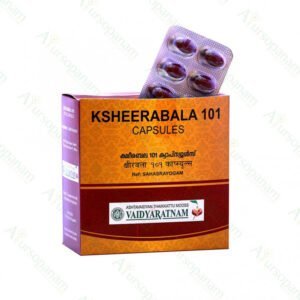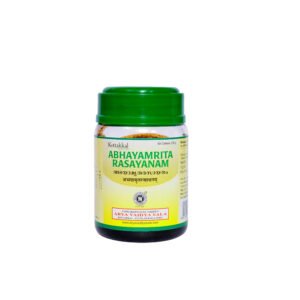‘Agni’ or the digestive fire is central to the Ayurvedic concept of health. A debilitated Agni gives rise to ‘Ajirna’, a condition characterized by incomplete digestion and metabolism. The individual suffers from loss of appetite, nausea and abdominal discomfort.
Chavikasavam is an ‘asava’ formulation mentioned in the context of ‘Ajirna’ chikitsa (treatment), with appetite-inducing ingredients that stimulate the metabolic agency or ‘Agni’. Asavas are mildly alcoholic preparations. The sweet taste of Chavikasavam makes it palatable to kids and adults alike. The alcohol base makes it quick-acting and efficient.
Features & Benefits
- The ‘digestive fire’ in a diabetes patient is weak. Chavikasavam works on metabolism as a whole. It improves digestion as well as absorption.
- It lowers insulin resistance in the body. Helps kick into action a sluggish basal metabolic rate.
- It breaks down ‘ama’ or disease-causing complexes in the body responsible for inflammation and disease.
- Chavikasavam is an excellent remedy for lack of appetite, indigestion and abdominal flatus. It is beneficial in the management of gut dysfunction associated with hemorrhoids and fistula.
- It enhances ‘Dhatwagni’ or tissue metabolism. Facilitates proper digestion and absorption in the gut. Ensures optimum nourishment and growth.
Dosage and Instructions
Adult: 25-30 ml Chavikasavam twice or thrice daily after food.
Child: 10-15 ml Chavikasavam once or twice daily after food.
Key Ingredients
Guda
Jaggery is known to produce heat and provides instant energy to the human body. It prevents constipation due to its laxative property and activates digestive enzymes. As per Ayurveda, eating Jaggery daily after meals improves digestion due to its Ushna (hot) property.
Chavika (Pipper mullesua)
It is used in Agnimandya (diminished digestive fire), Ajirna (indigestion) such as Grahaniroga (sprue syndrome), Visuchika(cholera) and Atisara (diarrhea). It is also indicated in antifungal in skin diseases and in Vishama Jwara (fever). It is used in amenorrhea to induce periods. It has specially indicated in respiratory disorders like cough, hiccough and asthma as it decreases sputum.
Chithraka(Plumbago zeylanica)
It is a potent digestive medicine used for treating a host of ailments including indigestion, constipation, anorexia, abdominal distension, stomatitis, abdominal pain, etc. Imbued with digestive, caustic, stimulant and carminative properties, it eliminates harmful ‘Ama’ toxins from the body which has accumulated due to malabsorption of food particles.
Pushkaramoola (Coffea travancorensis)
Pushkaramula has been used to treat cardiovascular and respiratory problems as well as for weight loss. Other conditions treated traditionally with Pushkaramula include bacterial infections, blood sugar metabolism problems, asthma, bronchitis, cough, and heart disease. Literature suggests that it works by protecting antioxidants in the body and increasing their function
Vacha (Acorus calamus)
Vacha is an ancient herb having various health benefits. The name “Vacha” in Sanskrit means speaking clearly because this herb stimulates intelligence and expression. in Ayurveda, Vacha is known as a rejuvenating herb because of its effect on the nervous system. According to Ayurveda, taking Vacha along with honey daily helps manage speech disorders due to its Vata balancing and Medhya (intelligence) properties.
Patola (Trichosanthes dioca)
Acharya Charaka has mentioned Patola as one of the herbs used in powder massage, useful in pruritus, acne and urticaria. Leaves and fruits of Patola are used in the treatment of alcoholism and jaundice. Soup of Patola fruit is also advisable in alcoholism. The Patola leaves juice is used in alopecia and liver enlargement. Regular eating of Patola vegetable helps to lose weight, increases the immune power, and also provide relief from abdominal diseases. Patola root is Sukha Virechaka and causes mild purgation.
Hareethaki (Terminalia chebula)
Popularly known as Indian walnut for its innumerable benefits or Indian hog plum in English, it is extremely valuable for its role in improving hair health. It is useful for treating scalp infections like dandruff, itching and hair fall. It also strengthens them from the roots, prevents breakage and loss of hair and bestows silky soft smooth hair. Chebulic Myrobalan is one of the three key ingredients in Triphala, a natural compound that provides overall support for digestive function and helps ensure that the digestive tract works at optimal levels. The Ayurvedic Pharmacopoeia of India has documented the use of the powdered herb in intermittent fevers and chronic fevers, anemia and polyuria. Chebulic Myrobalan can also be used to treat gastrointestinal and respiratory disorders.
Amalaki (Emblica officinal)
Commonly known as the Indian gooseberry, it is high in Vitamin C and natural antioxidants known as flavonoids and polyphenols. When used for hair treatments, it is found to strengthen and condition follicles down to the roots. Amla oil can promote hair growth, reduce dandruff, and prevent the graying of hair.
Vibhithaki (Terminalia Bellerica)
It is also known as Beach almonds or Bedda nut tree. It is rich in Vitamin C and other antioxidants that nourish the hair roots. Vibhitaki helps in making the roots of the hair stronger, minimizing hair fall and preventing premature graying of hair strands.
Kutaja (Holarrhena antidysenterica)
It is a traditional Ayurvedic remedy that has potent anti-dysenteric, antidiarrheal, anti-amoebic action and hemostatic properties for treating and curing a horde of ailments including dysentery, diarrhea, irritable bowel syndrome, malabsorption syndrome, intestinal infections and different bleeding disorders.
Dhanyaka (Coriandrum sativum)
Fresh leaves and seeds have been an integral parts of Indian dietetics. Chopped leaves and powdered coriander are used for garnishing various food items in India. Primarily both of them have a significant effect on the digestive process. Coriander prevents flatulence and controls spasmodic pain as recommended by Ayurveda. Extract of coriander seeds has a marked antispasmodic activity.
Vidanga (Embilia ribes)
It is commonly known as false black pepper. It has various medicinal properties and is used in various ayurvedic formulations. Vidanga is generally used to expel worms and parasites from the stomach due to its anthelmintic properties. It is beneficial for indigestion and also helps to manage constipation due to its laxative property.
Musta (Cyperus rotundus)
Musta is commonly known as Common Nutsedge. It is effective in gastritis and irritable bowel syndrome. Due to its breast purification property, it is used during postpartum care to avoid indigestion to the child. Nut Grass has a long history of medicinal use in the Ayurvedic system of medicine. Its benefits have been documented in the Charaka Samhita, one of Ayurveda’s prime texts. The herb also features heavily in the medicinal texts of Chinese Traditional Medicine (CTM). in CTM, Nut Grass is credited with the ability to restore ‘Qi’, the natural patterns in which the body functions.
Manjishtha (Rubia Cordifolia)
Manjishtha or Indian Madder is considered to be one of the best blood-purifying herbs. It is mainly used to break down blockages in the blood flow and remove stagnant blood. Manjishtha herb can be used both internally and externally on skin for promoting skin whitening. It helps manage acne and pimples by inhibiting the growth of acne-causing bacteria due to its antioxidant property.
Devadaru (Cedrus deodara)
Devadaru is also known as the Himalayan cedar. It is very effective in neurological disorders, asthma, pruritus and infested wound. Devadaru is also effective in arthritis and headache. Deodar oil contains two major sesquiterpenoids a and ß- himachalenes. Deodardione are also isolated from the essential oil. The oil shows invitro antibacterial, antifungal and anti-inflammatory activity.
Ela (Elettaria cardomum)
Commonly used as Elaichi, it has very good anti bacterial and anti fungal properties. It helps in reducing inflammation. Cardamom is often given the epithet ‘Queen of Spices’ as it is used to flavor food in many countries. in addition, the herb has several health benefits. The German Commission E has indicated the use of Cardamom in dyspepsia and as a cholagogue, which promotes bile discharge from the system. The herb is also helpful in treating gum and teeth infections, throat congestion and kidney disorders.
Pippali (Piper longum)
Pippali is known as a ‘tridoshic’ herb as it suits all body types. Thus regular consumption of Pippali in suggested quantity can help you to immune your body to quiet an extent. Pippali has anti-microbial and anti-inflammatory activity. Consumption of Pippali is said to exhibit anti spasmodic action and hypoglycaemic effect which is believed to lower blood sugar level. It is also reported to be antagonist in respiratory depression. Also due to its cooling post-digestive effect consumption of Pippali is considered as a safe and effective option to avoid all sorts of digestive disorders.
Maricha (Piper nigrum)
The creeper is native to Western Ghats of India. It is cultivated for its fruit, which is widely used as spice and in traditional Indian medicine preparation. Black pepper is an appetizer and a carminative commonly used in the treatment of digestive system related complaints like dyspepsia, indigestion, flatulence, nausea, diarrhoea and colic pain. in respiratory system it acts like an expectorant used in cough, cold and chest congestion. Externally used as analgesic and in Vitiligo it stimulates the production of pigments.
Shunti (Zingiber officinale)
Due to its strong flavor, Ginger is an essential ingredient in many Asian cuisines. Its therapeutic benefits have been recorded in Ayurvedic and Traditional Chinese Medicine. Ginger is a potent anti-nauseatic and is beneficial in treating upset stomach. Gingerol and shogaol, active components of Ginger, suppress gastric contractions. Both the fresh and dried rhizomes of Ginger suppress gastric secretion and reduce vomiting. The compounds 6-gingerol and 6-shogaol have a number of pharmacological properties, including antipyretic, analgesic, antitussive and hypotensive properties.
















































Ratings & Customer Reviews
Reviews
There are no reviews yet.